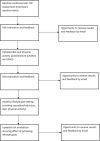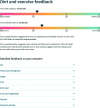The Healthy Hearts Project: Development and evaluation of a website for cardiovascular risk assessment and visualisation and self-management through healthy lifestyle goal-setting
- PMID: 38019808
- PMCID: PMC10686463
- DOI: 10.1371/journal.pdig.0000395
The Healthy Hearts Project: Development and evaluation of a website for cardiovascular risk assessment and visualisation and self-management through healthy lifestyle goal-setting
Abstract
Materially deprived communities in the UK have excess morbidity and mortality from cardiovascular disease (CVD) but are less likely to engage with formal care pathways. Community engagement and e-health may be more effective ways to promote risk-reducing lifestyle change. The "Healthy Hearts Project" website was designed for use by community health workers (CHWs) for cardiovascular risk assessment and lifestyle goal setting, or for independent use by community members. This paper describes the website's development and evaluation. The website was developed using interactive wire frame prototypes in a user-led approach. Qualitative evaluation of the completed website's usability and acceptability was conducted using the "Thinking Aloud" method in a purposive sample of 10 participants (one voluntary sector employee, three CHWs, two community members and four healthcare professionals). Thinking Aloud interview transcripts were thematically analysed using an inductive approach. A separate quantitative evaluation of usability and the effect of using the website on CVD knowledge and beliefs was conducted. A random sample of 134 participants, recruited using the online platform Prolific, completed the "Attitudes and Beliefs About Cardiovascular Disease" (ABCD) questionnaire before and after using the website, along with the System Usability Scale (SUS). Qualitative evaluation-Four key themes were identified: 1) Website functionality and design-participants generally found the website easy to use and understood the risk communication graphics and the feedback and goal-setting features,; 2) Inclusivity and representation-most participants considered the website inclusive of a range of users/cultures; 3) Language and comprehension-participants found the language used easy to understand but suggested reducing the amount of text; 4) Motivation and barriers to change-participants liked the personalized feedback and empowerment offered by goal-setting but commented on the need for self-motivation. Quantitative evaluation-The mean score across all domains of the ABCD questionnaire (from 2.99 to 3.11, p<0.001) and in the sub-domains relating to attitudes and beliefs around healthy eating and exercise increased after using the website. The mean(sd) score on the SUS was 77.5 (13.5). The website's usability was generally rated well by both quantitative and qualitative measures, and measures of CVD knowledge improved after use. A number of general recommendations for the design of eHealth behaviour change tools are made based on participants' suggestions to improve the website.
Copyright: © 2023 Rogers et al. This is an open access article distributed under the terms of the Creative Commons Attribution License, which permits unrestricted use, distribution, and reproduction in any medium, provided the original author and source are credited.
Conflict of interest statement
Nicola O’Connor is employed by William Joseph Ltd. The remaining authors have no competing interests.
Figures






Similar articles
-
The Development of a Digital Patient Navigation Tool to Increase Colorectal Cancer Screening Among Federally Qualified Health Center Patients: Acceptability and Usability Testing.JMIR Form Res. 2024 Sep 25;8:e53224. doi: 10.2196/53224. JMIR Form Res. 2024. PMID: 39321451 Free PMC article.
-
Parents' User Experience Accessing and Using a Web-Based Map of COVID-19 Recommendations for Health Decision-Making: Qualitative Descriptive Study.JMIR Form Res. 2024 Mar 20;8:e53593. doi: 10.2196/53593. JMIR Form Res. 2024. PMID: 38506915 Free PMC article.
-
An e-Mental Health Resource for COVID-19-Associated Stress Reduction: Mixed Methods Study of Reach, Usability, and User Perceptions.JMIR Ment Health. 2022 Aug 26;9(8):e39885. doi: 10.2196/39885. JMIR Ment Health. 2022. PMID: 35960596 Free PMC article.
-
A web-based resource for exercise training in children treated for brain tumours to improve cognitive sequelae: Development and usability.Digit Health. 2024 Sep 5;10:20552076241272710. doi: 10.1177/20552076241272710. eCollection 2024 Jan-Dec. Digit Health. 2024. PMID: 39262418 Free PMC article. Review.
-
Development and evaluation of a de-escalation training intervention in adult acute and forensic units: the EDITION systematic review and feasibility trial.Health Technol Assess. 2024 Jan;28(3):1-120. doi: 10.3310/FGGW6874. Health Technol Assess. 2024. PMID: 38343036 Free PMC article.
References
-
- World Health Organisation. Cardiovascular Diseases 2022. [cited 2nd October 2023]. Available from: https://www.who.int/health-topics/cardiovascular-diseases#tab=tab_1.
-
- Public Health England. Health matters: preventing cardiovascular disease [cited 2nd October 2023]. Available from: https://www.gov.uk/government/publications/health-matters-preventing-car....
-
- Evans H, Buck D. Tackling multiple unhealthy risk factors. Emerging lessons from practice. The Kings Fund; 2018. [cited 2nd October 2023]. Available from https://www.kingsfund.org.uk/publications/tackling-multiple-unhealthy-ri....
-
- Foster H, Celis-Morales C, Nicholl B, Petermann-Rocha F, Pell J, Gill J, et al.. The effect of socio-economic deprivation on the association between an extended measurement of unhealthy lifestyle factors and health outcomes: a prospective analysis of the UK Biobank cohort. Lancet Public Health. 2018;3:e576–e85. doi: 10.1016/S2468-2667(18)30200-7 - DOI - PubMed
LinkOut - more resources
Full Text Sources
